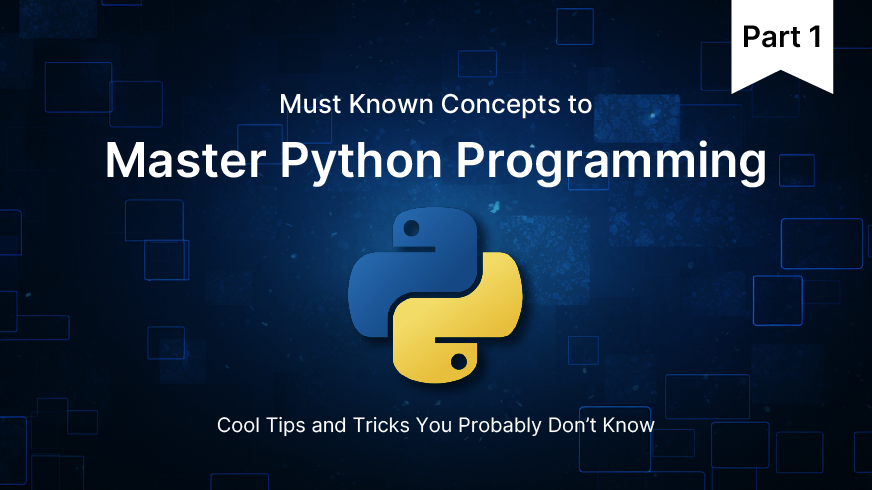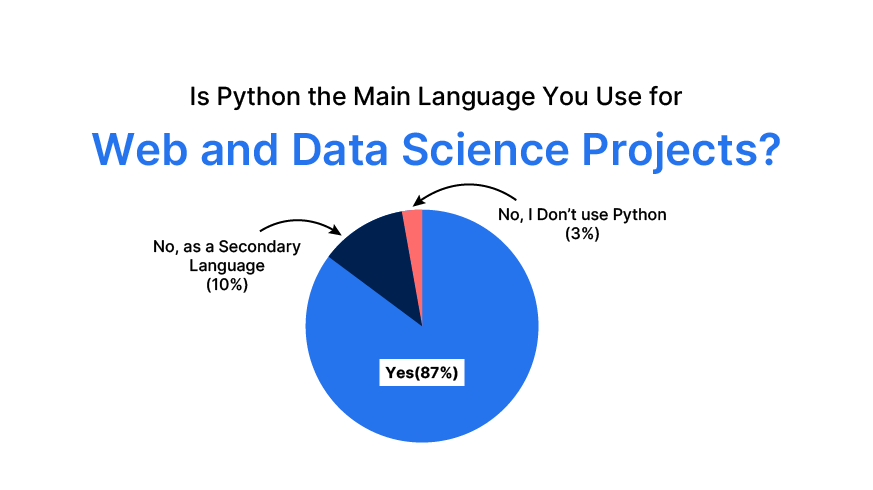Fundamentals of Python Programming for Beginners - Analytics Vidhya
Apr 20, 2025 am 11:19 AMIntroduction
Experienced data professionals have observed a shift in the dominance of certain technical skills, a trend supported by data. Before NumPy's 2005 release, Python was considered slow for numerical analysis. NumPy changed that. Pandas (2008) solidified Python's position as the premier language for data analysis.
The emergence of frameworks like SciKit-Learn, TensorFlow, and PyTorch further cemented Python's status as the leading programming language for data science (AI and machine learning).
While a few years ago, the choice between R and Python for data professionals was considered less critical, the rise of AI and LLMs has propelled Python to the forefront. This article presents essential Python tips and tricks to elevate your coding skills, regardless of your experience level.

Learning Objectives
This guide aims to ensure you confidently navigate production-level Python code by:
- Reinforcing your understanding of core Python concepts.
- Enhancing your comprehension of production code functionality.
- Enabling you to reproduce code and write features understood by your team.
A Python notebook containing all code examples is available for download [link to download]. This serves as a handy syntax reference.
Before delving into the details, let's address the key question: Why Python?
Table of Contents
- Why Master Python?
- Python Fundamentals
- Static vs. Dynamic Typing
- Static vs. Dynamic Binding
- Compilation in Programming Languages
- Key Python Keywords
- Identifiers vs. Variables
- Type Conversions
- Immutability in Python
- Memory-Level Considerations
- Primitive Datatypes' Immutability
- Object Deletion and Memory Management
- Efficient Coding Techniques
- Using the
anyOperator Instead ofor
- Using the
- String Manipulation
- The Importance of Unicode Characters
- Strings and Memory Management
- Printing Colored Text
- Opening a Web Browser
- Concatenation without the " " Operator
- The
split()String Method - The
join()String Method - Using the
inOperator for Substrings - Finding Indices with
find() - Using
id()to Get Object Identity - Aliases
- Modifying Print Output with
end - Printing Multiple Elements with Commas
- F-Strings for Formatting
- Returning and Assigning Multiple Values
- Ternary Conditional Operator and List Comprehensions
- Flag Variables
- Removing List Duplicates with Sets
- Using
infor Concise Conditionals
- Debugging Strategies
- Frequently Asked Questions
Why Master Python?
A significant 87% of data scientists use Python for their primary projects, with another 10% using it secondarily. This widespread adoption highlights its importance. Python is extensively used in Gen-AI, deep learning, data science, data analysis, web development, and web scraping. Its popularity in AI and machine learning stems from:
- Ease of Learning: Python boasts a simpler syntax than languages like C or Java, making it beginner-friendly.
-
Rich Libraries: It offers a wealth of built-in functions (e.g.,
print(),list(),str()) and libraries (e.g., NumPy, Pandas, Scikit-Learn) to streamline complex tasks. - Supportive Community: The large and active Python community provides readily available assistance.
Note: Python is case-sensitive. The snake_case convention (lowercase with underscores) is recommended to minimize syntax errors.
Let's explore the core aspects of Python programming.

Python Fundamentals
This section covers fundamental Python concepts:
Static vs. Dynamic Typing
-
Static Typing: Method invocation and property access are determined at compile time, improving type safety and potentially reducing execution time. (Example:
int q = 9;in C ) -
Dynamic Typing: Variable data types are determined at runtime, allowing for flexible type changes. (Example:
a = 1; a = "Hi";in Python)
Static vs. Dynamic Binding
- Static Binding (Early Binding): Method invocation is determined at compile time, leading to faster execution and improved type safety.
- Dynamic Binding (Late Binding): Method invocation is determined at runtime, offering greater flexibility and polymorphism.
Compilation in Programming Languages
Compilation transforms high-level code into machine-executable binary code. This is done using:
- Compilers: (e.g., Java, C , C) translate the entire code at once before execution.
- Interpreters: (e.g., Python, PHP) translate code line by line during execution.
Key Python Keywords
[Image of key Python keywords]
Identifiers vs. Variables
Identifiers are names used to uniquely identify objects (variables, functions, classes, etc.), while variables are names associated with memory locations storing values. Python identifier rules include:
- Cannot begin with a digit.
- Can contain uppercase/lowercase letters, digits, and underscores.
- Cannot be keywords.
Type Conversions
Type conversion (or type casting) changes an object's data type. Python supports:
- Implicit Type Conversion: The interpreter automatically handles type conversion to minimize data loss.
-
Explicit Type Conversion: Using functions like
int(),float(), andstr()to explicitly convert types. Caution is needed to avoid data loss.
Immutability in Python
-
Immutable objects:
int,float,complex,str,tuple,frozenset. Their values cannot be changed after creation. -
Mutable objects:
list,dict,set,bytearray. Their values can be modified in place.
Memory-Level Considerations
Immutable object modifications create new objects in memory, while mutable object changes occur within the existing memory allocation.
Primitive Datatypes' Immutability
The id() function reveals the unique memory address of an object. This demonstrates that modifying an immutable object creates a new object with a different memory address.
Object Deletion and Memory Management
Python's memory management uses:
- Reference Counting: Each object tracks its references. When the count reaches zero, the memory is freed.
- Cyclic Garbage Collection: Handles situations where objects circularly reference each other, preventing memory leaks.
Efficient Coding Techniques
[Continue with the remaining sections, adapting the style and content as shown in the previous examples.]
The above is the detailed content of Fundamentals of Python Programming for Beginners - Analytics Vidhya. For more information, please follow other related articles on the PHP Chinese website!

Hot AI Tools

Undress AI Tool
Undress images for free

Undresser.AI Undress
AI-powered app for creating realistic nude photos

AI Clothes Remover
Online AI tool for removing clothes from photos.

Clothoff.io
AI clothes remover

Video Face Swap
Swap faces in any video effortlessly with our completely free AI face swap tool!

Hot Article

Hot Tools

Notepad++7.3.1
Easy-to-use and free code editor

SublimeText3 Chinese version
Chinese version, very easy to use

Zend Studio 13.0.1
Powerful PHP integrated development environment

Dreamweaver CS6
Visual web development tools

SublimeText3 Mac version
God-level code editing software (SublimeText3)

Hot Topics
 From Adoption To Advantage: 10 Trends Shaping Enterprise LLMs In 2025
Jun 20, 2025 am 11:13 AM
From Adoption To Advantage: 10 Trends Shaping Enterprise LLMs In 2025
Jun 20, 2025 am 11:13 AM
Here are ten compelling trends reshaping the enterprise AI landscape.Rising Financial Commitment to LLMsOrganizations are significantly increasing their investments in LLMs, with 72% expecting their spending to rise this year. Currently, nearly 40% a
 AI Investor Stuck At A Standstill? 3 Strategic Paths To Buy, Build, Or Partner With AI Vendors
Jul 02, 2025 am 11:13 AM
AI Investor Stuck At A Standstill? 3 Strategic Paths To Buy, Build, Or Partner With AI Vendors
Jul 02, 2025 am 11:13 AM
Investing is booming, but capital alone isn’t enough. With valuations rising and distinctiveness fading, investors in AI-focused venture funds must make a key decision: Buy, build, or partner to gain an edge? Here’s how to evaluate each option—and pr
 The Unstoppable Growth Of Generative AI (AI Outlook Part 1)
Jun 21, 2025 am 11:11 AM
The Unstoppable Growth Of Generative AI (AI Outlook Part 1)
Jun 21, 2025 am 11:11 AM
Disclosure: My company, Tirias Research, has consulted for IBM, Nvidia, and other companies mentioned in this article.Growth driversThe surge in generative AI adoption was more dramatic than even the most optimistic projections could predict. Then, a
 New Gallup Report: AI Culture Readiness Demands New Mindsets
Jun 19, 2025 am 11:16 AM
New Gallup Report: AI Culture Readiness Demands New Mindsets
Jun 19, 2025 am 11:16 AM
The gap between widespread adoption and emotional preparedness reveals something essential about how humans are engaging with their growing array of digital companions. We are entering a phase of coexistence where algorithms weave into our daily live
 These Startups Are Helping Businesses Show Up In AI Search Summaries
Jun 20, 2025 am 11:16 AM
These Startups Are Helping Businesses Show Up In AI Search Summaries
Jun 20, 2025 am 11:16 AM
Those days are numbered, thanks to AI. Search traffic for businesses like travel site Kayak and edtech company Chegg is declining, partly because 60% of searches on sites like Google aren’t resulting in users clicking any links, according to one stud
 AGI And AI Superintelligence Are Going To Sharply Hit The Human Ceiling Assumption Barrier
Jul 04, 2025 am 11:10 AM
AGI And AI Superintelligence Are Going To Sharply Hit The Human Ceiling Assumption Barrier
Jul 04, 2025 am 11:10 AM
Let’s talk about it. This analysis of an innovative AI breakthrough is part of my ongoing Forbes column coverage on the latest in AI, including identifying and explaining various impactful AI complexities (see the link here). Heading Toward AGI And
 Cisco Charts Its Agentic AI Journey At Cisco Live U.S. 2025
Jun 19, 2025 am 11:10 AM
Cisco Charts Its Agentic AI Journey At Cisco Live U.S. 2025
Jun 19, 2025 am 11:10 AM
Let’s take a closer look at what I found most significant — and how Cisco might build upon its current efforts to further realize its ambitions.(Note: Cisco is an advisory client of my firm, Moor Insights & Strategy.)Focusing On Agentic AI And Cu
 Build Your First LLM Application: A Beginner's Tutorial
Jun 24, 2025 am 10:13 AM
Build Your First LLM Application: A Beginner's Tutorial
Jun 24, 2025 am 10:13 AM
Have you ever tried to build your own Large Language Model (LLM) application? Ever wondered how people are making their own LLM application to increase their productivity? LLM applications have proven to be useful in every aspect






